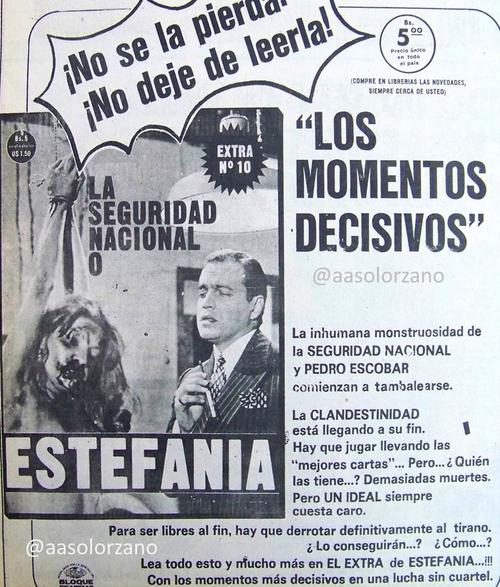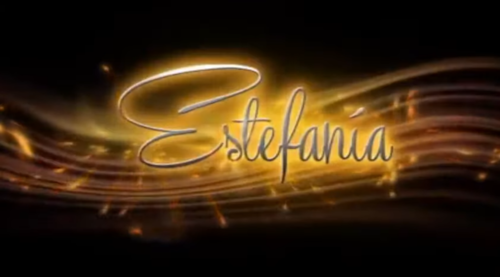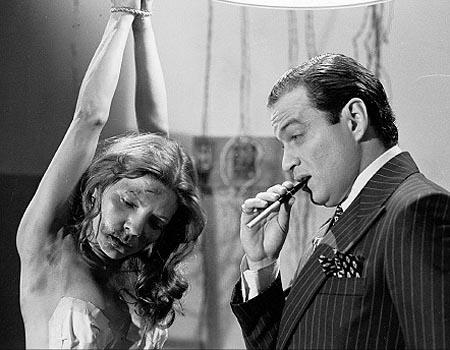Estefania
The telenovela Estefania in a magazine
Image Credit: From the Twitter account @aasolorzano:
https://twitter.com/search?q=estefania%20%40aasolorzano&src=typed_query
Published on October 28, 2016
Accessed 04.06.2021
The logo of the telenovela Estefania
Image Credit: Taken from:
https://tigrero-literario.blogspot.com/2010/02/estefania-cuando-una-telenovela-hace.html
Accesed on 21.11.2021
Estefania's torture, frame from the Telenovela
Image Credit: Taken from:
https://tigrero-literario.blogspot.com/2010/02/estefania-cuando-una-telenovela-hace.html
Accesed on 21.11.2021
Estefanía is a Venezuelan telenovela depicting the underground struggle against the dictatorial military government of Marcos Pérez Jiménez in the 1950s. The telenovela was first broadcast in Venezuela on Radio Caracas Televisión (RCTV) between 1 July 1979 and 27 January 1980 at 9 p.m. Monday to Saturday and was a great success with the audience.
The telenovela is about the last months of the dictatorship of Marcos Pérez Jiménez until its fall in 1958, told through a love story between young people who belong to the underground struggle and play different roles in it. Estefanía shows for the first time the human rights violations of the police secret service Seguridad Nacional (Dirección de Seguridad Nacional - DSN). The screenwriter, Julio César Mármol (1937 - 2010), was a direct witness to this: At the age of 17, after participating in a protest by students against the military government of Pérez Jiménez, he was arrested and imprisoned for six months in the dungeons of the State Security.
In the telenovela, the names of some characters are easily identifiable with people from the historical context: the politician, military and dictator Marcos Pérez Jiménez, who ruled Venezuela from 1951 to 1958, is called Marco Suarez Figueres in the telenovela; the director of the National Security Directorate (1951 - 1958), Pedro de Alcántara Estrada Albornoz, whose character is called Pedro Escobar in the telenovela (played by Gustavo Rodríguez); and Miguel Silvio Sanz Añez, head of the Political-Social Department of the DSN, whose name in the plot is Manuel Fulvio Lanz (played by Tomás Henríquez).
When Estefanía was first shown in 1979, 22 years after the fall of Marcos Pérez Jiménez's regime, part of the audience witnessed the events it depicted. Parts from certain chapters of the telenovela can be seen on YouTube, here are some comments from viewers:
"Pedro Estrada was born in the same town as my grandparents, they knew him, and I clearly remember my grandmother watching the telenovela and saying, "If he wasn't so little, I would say it was him..." [2020-06-09 02:50:25, comment "Estefanía | Episode 1 | José Luis Rodríguez y Pierina España | Telenovelas RCTV" https://www.youtube.com/watch?v=yDwNRzEUqoI&t=462s. Access date: 2020-12-17]
"Excellent performance by Gustavo Rodríguez as Pedro Estrada, they say it was like watching the real hitman from Pérez Jiménez" [2020-03-27 04:43:17, comment "Estefanía | Episode 1 | José Luis Rodríguez y Pierina España | Telenovelas RCTV" https://www.youtube.com/watch?v=yDwNRzEUqoI&t=462s. Access date: 2020/12/17]
"Good evening, great telenovela, a success! This is what is happening today in the Republic of Venezuela, my congratulations to RCTV for downloading this precious telenovela, thank you, greetings!", [2020-03-07 05:01:36, comment "Estefanía | Episode 1 | José Luis Rodríguez y Pierina España | Telenovelas RCTV" https://www.youtube.com/watch?v=yDwNRzEUqoI&t=462s. Access date: 2020/12/17]
"I watched this telenovela in the living room of my house with my three sisters, my little brother and my parents, I was only 9 years old, and it educated the whole country about the true meaning of the words tyranny, dictatorship and DEMOCRACY, it was such a boom in my little school that in the third grade we did a graduation ceremony called Estefanía, and to everyone's surprise, several of the main characters were there, San Rafael parish school 1980" [2018-05-02 11: 19:17, Kommenztar Estefanía Capitulo 133 final, https://www. youtube.com/watch?v=9HkmmOV46Qk, Access date: 2020-12-17]
Sources and References
Cuevas, Daniel (2019): Sobre Estefanía, la telenovela venezolana de 1979. In: El Nacional, 24.10.2019. Online verfügbar unter https://www.elnacional.com/papel-literario/sobre-estefania-la-telenovela-venezolana-de-1979-2/, zuletzt geprüft am 07.06.2021.
Fundación CIEV (2021): El miedo que nos enseñó la Seguridad Nacional. 23 de enero. Online verfügbar unter https://www.fundacionciev.com/el-miedo-que-nos-enseno-la-seguridad-nacional-a-proposito-del-23-de-enero/, zuletzt aktualisiert am 07.06.2021, zuletzt geprüft am 07.06.2021.
Recordaresvivir (2021): Murió el escritor Julio Cesar Marmol. Online verfügbar unter https://www.tapatalk.com/groups/recordaresvivir/murio-el-escritor-julio-cesar-marmol-t36133.html, zuletzt aktualisiert am 07.06.2021, zuletzt geprüft am 07.06.2021.
Retrorecuerdos de Ayer: Estefanía (telenovela). amor en tiempos de dictadura (2021). Online verfügbar unter https://retrorecuerdosdeayer.blogspot.com/2018/12/estefania-telenovela-amor-en-tiempos-de.html, zuletzt aktualisiert am 22.02.2021, zuletzt geprüft am 07.06.2021.
Wikipedia (Hg.) (2021): Estefanía (telenovela de 1979). Online verfügbar unter https://es.wikipedia.org/w/index.php?title=Estefanía_(telenovela_de_1979)&oldid=135134394, zuletzt aktualisiert am 28.04.2021, zuletzt geprüft am 07.06.2021.



